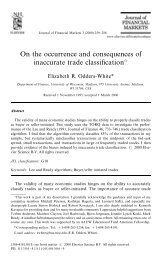A generic framework for Arabic to English machine ... - Acsu Buffalo
A generic framework for Arabic to English machine ... - Acsu Buffalo
A generic framework for Arabic to English machine ... - Acsu Buffalo
Create successful ePaper yourself
Turn your PDF publications into a flip-book with our unique Google optimized e-Paper software.
8.1. THESIS SUMMARY<br />
and so we hope our work will be the beginning of more work in this arena. We believe<br />
this serves as an excellent foundation <strong>for</strong> further research in the area.<br />
While statistical <strong>machine</strong> translation has been promoted by many, we believe that lan-<br />
gauges, expecially rich languages like <strong>Arabic</strong>, are very organised and structural, and<br />
such approaches cannot correctly deal with the wide variety of sentence structures. When<br />
these systems cannot deal with simplex sentences, as we have shown in Chapter 7, how<br />
do we expect them <strong>to</strong> correctly translate whole paragraphs? In our approach, we expect<br />
that high quality translations of simplex sentences are the only basis which can build <strong>to</strong><br />
good translations of whole paragraphs. The results we have presented are the first step<br />
in applying RRG <strong>to</strong> sophisticated translation. By focussing in this initial stage on the<br />
basics, we build a more solid foundation <strong>for</strong> the next stage.<br />
8.1 Thesis summary<br />
In Chapter 2, we presented a summary overview of the grammatical structure of the Ara-<br />
bic language. We detailed various sentence structures as well as unique word attributes<br />
like gender rules applied <strong>to</strong> all words and duality in number. We discussed how some of<br />
these properties could be used <strong>to</strong> extract in<strong>for</strong>mation about sentence structure.<br />
In Chapter 3, we presented the Role and Reference Grammar model, and showed how it<br />
could be used <strong>to</strong> deduce the logical structure of sentences and produce a lexical represen-<br />
tation which could be used as the interlingua.<br />
In Chapter 4, we presented various approaches <strong>to</strong> <strong>machine</strong> translation. We compared<br />
direct translation, transfer systems and interlingua systems and showed how interlingua<br />
systems require significantly more ef<strong>for</strong>t in the analysis and generation stages, but have<br />
131
















